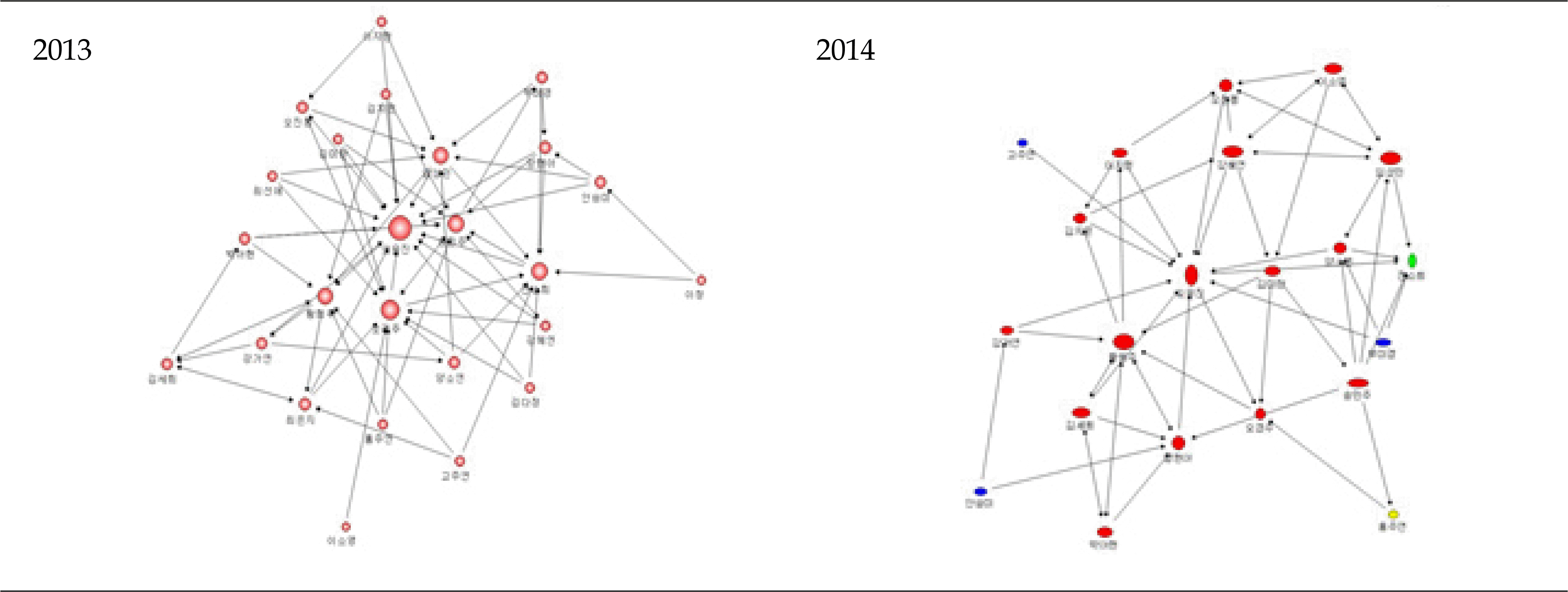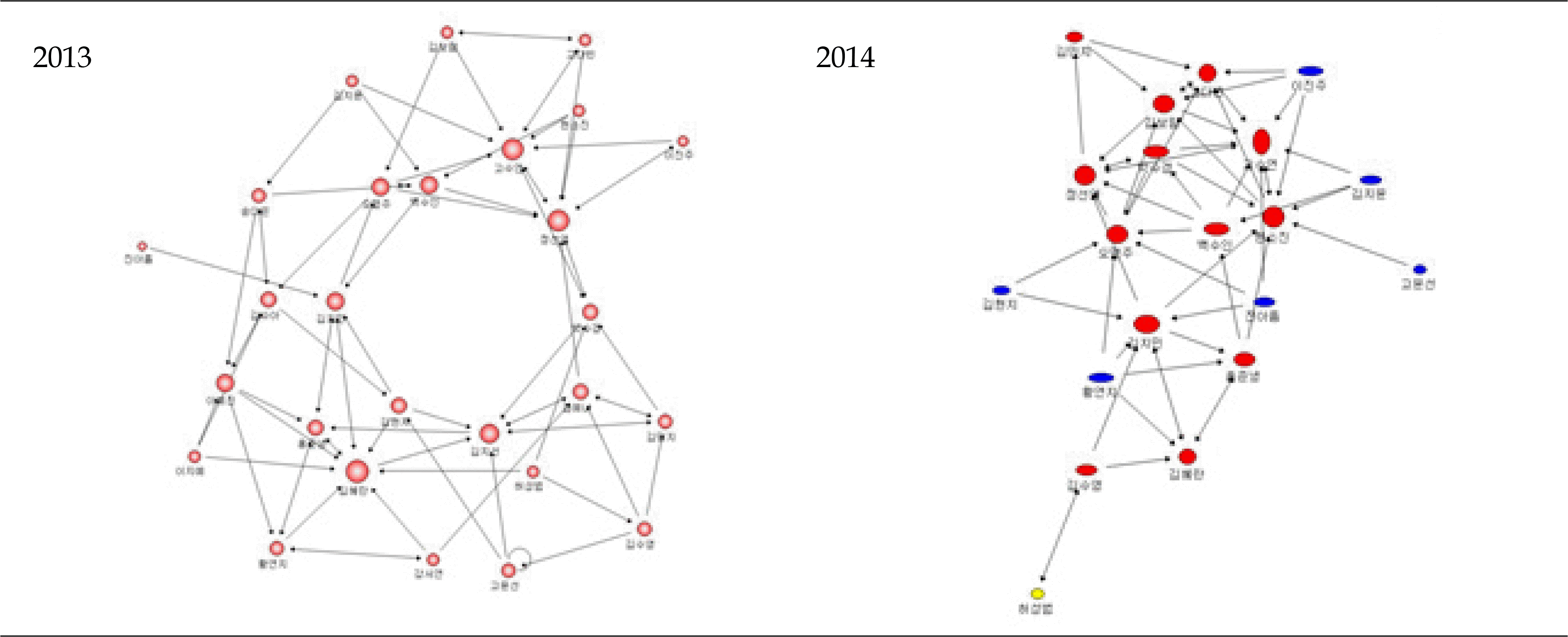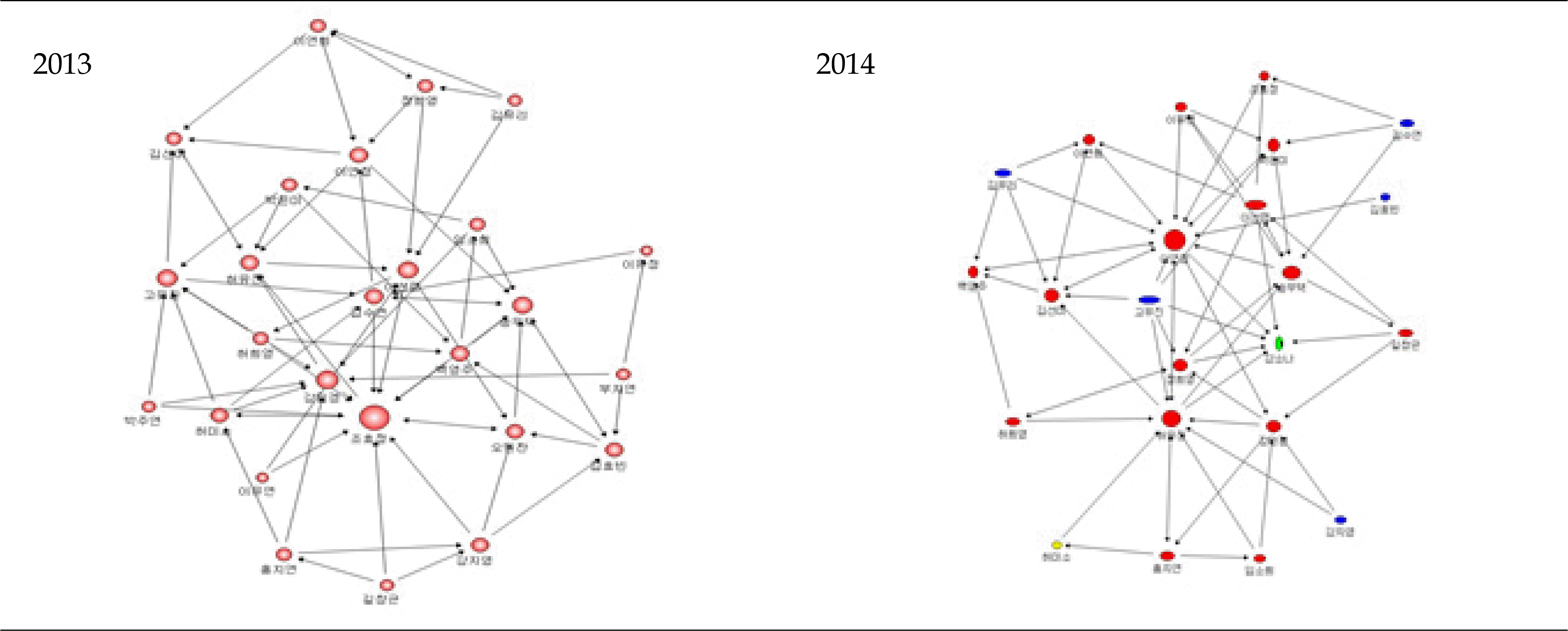Abstract
Purpose:
This study aimed to explore the underlying structures of students’ interaction networks to monitor network changes during the year, to verify the relationship with self-directed learning, and to identify the effect of problem-based learning on interaction and self-directed learning. Methods: A longitudinal study was designed which included 3 parts (A=25, B=27, C=26) with a total of 78 second-year nursing students from 2013 to 2014. Interaction indicators used group network centralization and density, and individual in-degree centrality. Results: Group network centralization showed mean reversion patterns, however, centralization and density showed a slight increase from 2013 to 2014 (Centralization of A part from 52.78 to 36.96, B part from 20.56 to 32.20, C part from 34.40 to 37.24; Density of A part from 0.122 to 0.123, B part from 0.111 to 0.121, C part from 0.109 to 0.121). The individual in-degree centrality is significantly correlated with self-directed learning and the correlation coefficient increased during the year (r=.274 in 2013, r=.356 in 2014, p<.001). Conclusion: Students share information more interactively during the year and the more they share the higher the scores of self-directed learning.
Go to : 
REFERENCES
1.Barrows HS. A taxonomy of problem-based learning methods. J Med Educ. 1986. 20(6):481–6. http://dx.doi.org/10.1111/j.1365-2923.1986.tb01386.x.

2.Hong GC. A meta-analysis on the effects of problem-based learning. J Educ Stud. 2008. 39(3):79–110.
3.Kang MH., Kang JH., Choi HS., Um SY. The effects of learners' perceived roles of a tutor on interactions and learning outcomes of problem-based learning in medical education. J Educ Stud. 2008. 39(3):1–25.
4.Moore MG., Kearsley G. Distance education: a systems view. Belmont: Wads Worth;1996.
5.Cho H., Stefanone M., Gay G. Social network analysis of information sharing networks in a CSCL community. Proceeding of the Conference on Computer Support for Collaborative Learning: Foundation for a CSCL Community. 2002 Jan 7-11; Boulder, USA. Mahwah: Lawrence Erlbaum Associates;. 2002.
6.Kim DS., Kang YG. The effects of the social network data presentation on interaction processes and products in computer supported collaborative learning environment. J Educ Technol. 2004. 20(1):89–115.

7.Chang DJ. Classroom networks and study performance. J Soc Stud Educ. 2000. 4:161–85.
8.Kim YH. Social network theory. Seoul: Pakyoungsa;2007.
9.Shin IS., Kim JH. The effect of problem-based learning in nursing education: a meta-analysis. Adv Health Sci Educ Theory Pract. 2013. 18(5):1103–20.

10.Kim YH. Social network analysis. Seoul: Parkyoungsa;2011.
11.Park JY. A study on the development and the effects of self-directed learning model by project method [dissertation]. Gang-neung: Catholic Kwandong University;2008.
12.Kim DH., Park JY., Lee NY. Factors influencing problem solving ability among nursing students. J Korean Data Anal Soc. 2012. 14(3):1551–63.
13.Mehra A., Kilduff M., Brass D. The social network of high and low self-monitors: implications for workplace performance. Adm Sci Q. 2001. 46(1):121–46. http://dx.doi.org/10.2307/2667127.
14.Lee SS. An analysis of interaction patterns in face-to-face and online synchronous/asynchronous learning environments. J Educ Technol. 2004. 20(1):63–88.

15.Cho H., Gay G., Davidson B., Ingraffea A. Social networks, communication styles and learning performance in a CSCL community. Comput Educ. 2007. 49(2):309–29. http://dx.doi.org/10.1016/j.compedu.2005.07.003.

16.Aviv R., Erlich Z., Ravid G., Geva A. Network analysis of knowledge construction in asynchronous learning networks. J Asynchronous Learn Netw. 2003. 7(3):1–23.

17.Park ES., Choi MS. The effect of learners' social network centralities on knowledge construction in online debating learning. J Educ Inf Media. 2011. 17(3):353–77.
18.Nam CW. The effects of students' centrality of social network on their academic achievement and attitude toward online cooperative learning. J Yeolin Educ. 2012. 20(2):51–73.
19.De Laat M. Network and content analysis in an online community discourse. Proceeding of the Conference on Computer Support for Collaborative Learning: Foundations for a CSCL Community; 2002 Jan 7-11; Boulder, USA. Mahwah: Lawrence Erlbaum Associates;. 2002.
20.Shin HS. The case studies about communication education, applying problem-based learning. J Korean Educ Forum. 2011. 10(3):137–69.
21.Jo YS. The Theory and practice of problem based learning. Seoul: Hakjisa;2006.
22.Chae SJ., Lim GY. An analysis of the relationship between intragroup peer assessment results and self-directed learning readiness in a leadership curriculum. Korean J Med Educ. 2008. 20(4):363–6.

23.Lee HJ., Kim MJ., Chung SK. The relationship between critical thinking disposition and lifelong core competency of college students. J Korean Data Anal Soc. 2012. 14(3B):1535–49.
24.Kim CH. Study on the relationships between participation in sport activities, social network and school life adjustment among the adolescents [dissertation]. Incheon: Inha University;2010.
25.Lim KY., Heo HO., Kim YS. Team leaders' interaction patterns in online team project. J Educ Inf Media. 2009. 15(4):295–317.
26.Palonen T., Hakkarainen K. Patterns of interaction in computer-supported learning: a social network analysis. Proceedings of the Fourth International Conference of the Learning Sciences. 2000. June 14-17; Ann Arbor, USA. Mahwah: Lawrence Erlbaum Associate; 2000.
27.Kang MJ., Piao MH., Park CS. The effects of students' interaction on self-directed learning and learner satisfaction in PBL class-a social network analysis. J Korean Data Anal Soc. 2014. 16(5):2807–18.
28.Cho YS., Chae JS., Baek EJ., Lim HH. A theoretic study on the teaching-learning process for problem-based learning (PBL) in elementary school classrooms. Korean J Educ Methodol Stud. 2004. 16(2):1–28.
Go to : 
Table 1.
Study Interaction Network Characteristics by Classes
| Classes | 2013 | 2014 | ||
|---|---|---|---|---|
| Centralization | Density | Centralization | Density | |
| A | 52.78 | 0.122 | 36.96 | 0.123 |
| B | 20.56 | 0.111 | 32.20 | 0.121 |
| C | 34.40 | 0.109 | 37.24 | 0.121 |
Table 2.
Individual in-degree Centrality and Self-directed Learning
| Variables | 2013 | 2014 | t∗ (p) |
|---|---|---|---|
| M±SD | M±SD | ||
| Self-directed learning | 3.31±0.33 | 3.06±0.52 | 3.838 |
| (<.001) | |||
| Individual in-degree centrality∗ | 0.12±0.12 | 0.14±0.11 | 1.447 |
| (.153) | |||




 PDF
PDF ePub
ePub Citation
Citation Print
Print





 XML Download
XML Download